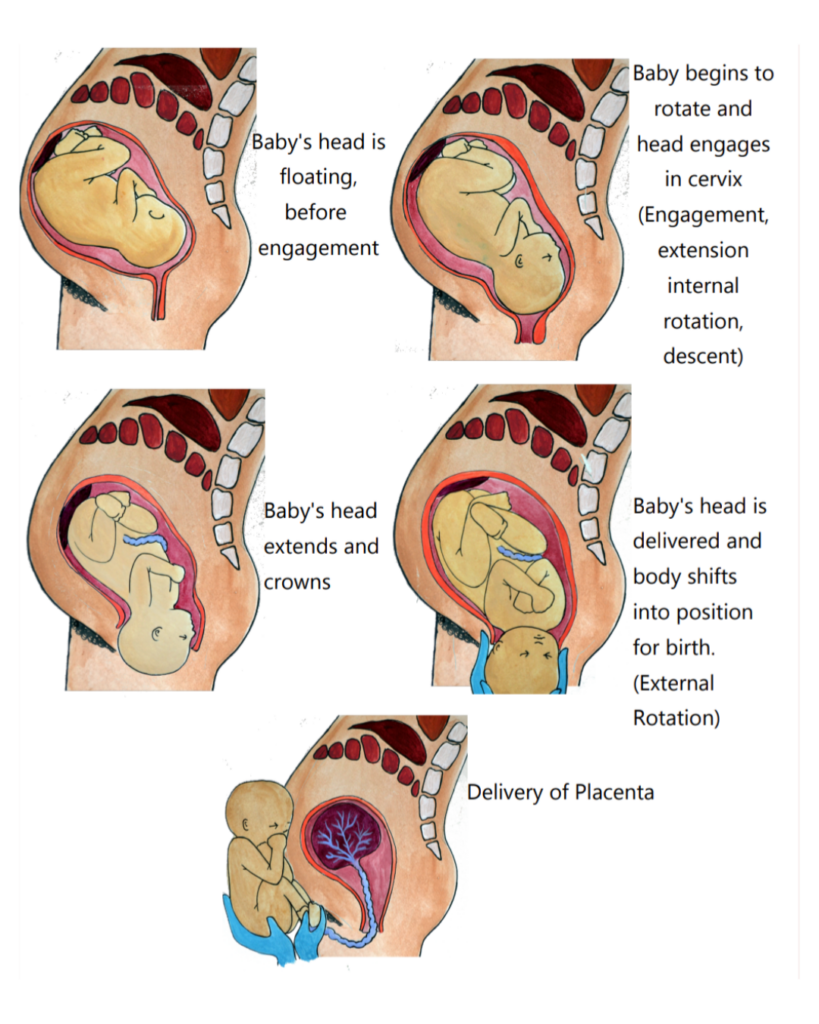
Your breath is your power, in and out of birth. Your breath can ground you emotionally and physically >>
A deep breath relaxes your central nervous system and oxygenates your vital organs, two things that reduce stress hormones while increasing hormones that relax you, drop you into the present moment and bring clarity to the mind. All things that can support you in birth.
Breathwork in labor also helps keep baby safe and strong as they navigate the pelvic bowl and tolerate the strains of birth.
Beyond supporting you and baby in birth, you can use breathwork with other tools like >>
•sounds and vocalization
•movement, dance, stretches and exercises
•mindset and visualization
to birth your baby and help you and baby adapt to the ebbs and flows of labor.
Breathwork
You will use breathwork to harness the power behind the urge to push, to slow down time and space to give your baby the chance to navigate the outlet and give your body the chance to open.
Exhaling and panting are breathing techniques use to release energy
Inhaling and slow breathing are used to harness energy.
These techniques will support you when you have the urge to push, when you begin pushing, as baby crowns and as they birth through your perineum.
They will help you create space, channel energy and prevent tearing.

moments and movements baby makes leading up to birth
Let’s review the moments and movements baby makes leading up to birth so we can better understand tools like breathwork.
First, baby must do their Cardinal Movements, they dance and move through labor just like you will.
Second, they birth through the cervix and they reach your pelvic floor
Third, they crown and then birth their head
And lastly, they birth their body
It is important to understand how baby births so you can best use breathwork and other tools to support them as they move down and out and to support your body as it labors.
The Cardinal Movements
The Cardinal Movements are a series of movements your baby makes throughout labor & birth to navigate the three levels of the pelvic bowl-inlet, midpelvis, & outlet.
The Cardinal Movements unfold as follows

Support baby’s cardinal movements
You can use breathwork, sound, massage and movement to release tension in the lower back, hips and pelvic floor. Keeping you body soft and allowing yourself to surrender to birth will create space in your pelvic bowl giving baby the chance to do their cardinal movements.
Listening to your body and intuition: let it guide you into positions that feel right to you
Breathwork: Long, slow and deep breathing to keep you soft and grounded.
Pelvic Floor
We want to slow things down as baby is moving along your pelvic floor and emerging from your vulva.
The pelvic floor is made up of four muscle groups that lattice at the root of your feminine power. When baby comes down on the pelvic floor it activates your brainwaves, grounds you both in the ethereal space and earthside, and it intensifies the sensations of birth.
This is your chance for a euphoric experience.
Baby’s head on your pelvic floor will bring you back into your body just in time to focus on relaxing and contracting the pelvic floor, allowing you to gain control of how you push.
Breathwork and maternal positioning are the keys to a smooth birth both for you and for baby.
Change positions as your intuition tells you to, keep pressure off your sacrum and incorporate subtle movements, micro shifts. this can look like rhythmic swaying, rocking or micro adjustments to your position.
Vibration soothes the central nervous system. Use chanting, humming or innate vocalizations to send vibrations through the body and to activate your brainwaves and engage flow state.
Breathwork: Long, slow and deep breathing to keep you soft and grounded.
Crowning
Your baby will move through your pelvic bowl by following the cardinal movements. When baby lifts their head and moves their chin away from their chest they slowly crown through your perineum.
This sensation can feel intense physically, emotionally, and energetically as baby’s head comes through your root chakra, your pelvic floor and emerges earthside.
Breathwork:
Quick and deep inhales to oxygenate you and baby
Long and slow exhales to release excess power behind your urge to push. This keeps slows down baby, gives your perineum the chance to stretch and prevents tearing

Tearing
Your tissues and ligaments are in the best condition to stretch at this point in your life. Your tissues have softened all through pregnancy and labor from hormones and down ward pressure.
To avoid tearing you’ll want to use your breath, listen to your body as it guides you into the best position and birth baby slowing and intuitively.
There are four types of tears. Grade 1-Grade 4
Grade 1 is a mild skid or tiny sliver within the top layer of tissue
Grade 2 mild to moderate tearing into the vaginal tissue
Grade 3 moderate to severe tearing through the vaginal tissue at the base of the anal sphincter
Grade 4 severe tearing through the anal sphincter
Common homebirth tears are Grade 1 and 2.
Healing
If you do tear, you likely won’t feel it in the moment.
but…in postpartum, you’ll want to be mindful when moving, using your core, bathing & going to the bathroom.
Time and space mama, resting and avoiding positions like butterfly sitting or activities like walking up stairs can help keep the tissues approximating, allowing them to come together and heal over time.
The more you rest the faster you will heal.
I want to recognize that not all mamas have the support or resources they need to rest fully in postpartum.
Herbs
My favorite herbs for your padsicles, peri bottle tea, and sitz bath include >>>>
THYME
LAVENDAR
CHAMOMILE
CALENDULA
PLANTAIN
ROSE
Breathwork for Postpartum
While breathwork will help you navigate labor and birth, it is also so beneficial in postpartum. Deep intentional breathing oxygenates the body, including the brain & other vital organs. It triggers our central nervous system, tells our body & brain that we are safe, grounding us & allowing our other systems to unfold properly. Intentional breathwork is meditative & can activate flow state. This will be your biggest ally in motherhood.